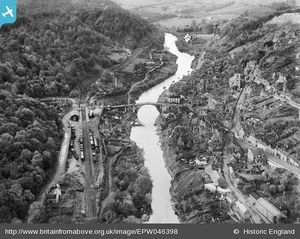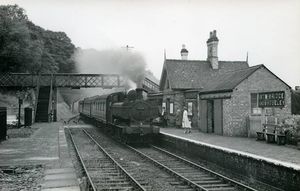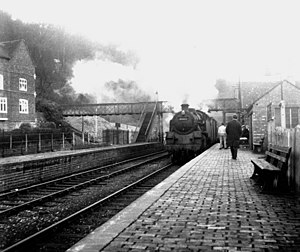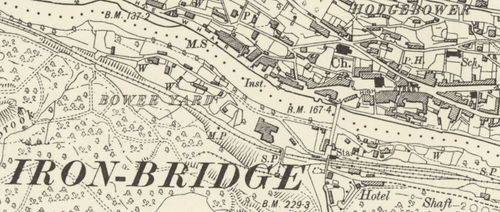Ironbridge and Broseley

| Towards Hartlebury and Kidderminster | Towards Shrewsbury |
|---|---|
| Coalport (2 miles) via Jackfield Halt (from 1934) |
Buildwas (1½ miles) |
Ironbridge and Broseley, re-named "Iron Bridge and Broseley" in 1895 and often abbreviated to simply "Ironbridge", was a station situated 27 miles from Hartlebury and 13¾ miles from Shrewsbury.
Contents
Location
Ironbridge, like all the stations north of Victoria Bridge, was built on the west bank of the River Severn. The river runs almost due east-west at Ironbridge, and thus the station was situated on what was effectively the south bank, immediately south of Abraham Darby’s bridge after which the town was named. The Gorge is very narrow at this point, and much of the station lay on an embankment and plateau supported by a 15 metre high retaining wall.[1]
The station was probably used more by the people of Broseley, situated about ½ mile away on the same side of the river, and the site of tile and clay pipe making industries. The 1861 census showed the population of Broseley as 4,724, larger than Ironbridge (3,154). Ironbridge town itself is on the north bank, and crossing the bridge required payment of a toll until 1950, a fact that undoubtedly discouraged passengers from Ironbridge using the station.[1] Nearby Coalbrookdale, also on the north bank, had its own station on the Wellington-Much Wenlock line.
History
At opening on 1 February 1862, the station was the second of five crossing points south of Shrewsbury (Buildwas being the first and Bridgnorth the next). Like all the main stations, Ironbridge had a goods yard and goods shed, although the latter was built of wood rather than stone.[2]
The station had a footbridge, adjacent to the station building, connecting the two platforms. The station building was on the platform to the north of the line (nearer Ironbridge), while the goods shed was to the south of the line. A road level crossing was situated immediately west of the station; this can be seen beneath the carriages in the Sellick photograph. The road led to Bower Yard and also to the Iron Bridge.
A Great Western Type 5 brick signal box was commissioned in 1894 at a cost of around £1,545.[3] This was located adjacent to the level crossing on the west side.
On 9 November 1895 the name of the station was changed from 'Ironbridge and Broseley' to 'Iron Bridge and Broseley' on the recommendation of the General Manager.[4] The reason for this is unclear as the town is normally referred to as 'Ironbridge'; however the latter name for the station continued in use as may be seen in working timetables and on the running-in board in the Sellick photograph.
Provision of an additional goods siding at a cost of £90 was authorised in April 1908, and the signal box interlocking frame, level crossing gates, point and signal connections were renewed in 1916[4].
GWR staff records for 1922 show the station had a staff of 17, including those working at Jackfield sidings and Maw and Co's Siding.
On 25 November 1956 the signal box at Ironbridge was closed and the down line and platform were taken out of use, ending the station’s use as a crossing point.[5] By 1962 the upper floor of the box had been removed and a small ground frame was installed outside the door.
The station closed to passenger traffic on 9 September 1963 when through traffic ended on the Severn Valley Line between Shrewsbury and Bewdley. However the goods yard remained open until 1 December 1963.[6]
The site today has become a pay and display car park for Ironbridge visitors, with few traces of the station remaining.
Traffic statistics
| Passenger Traffic | Freight Traffic | |||||
|---|---|---|---|---|---|---|
| Year | Tickets issued | Parcels despatched | Revenue (£) | Tons received & despatched | Revenue (£) | Total revenue (£) |
| 1903 | 29,845 | 19,240 | 3,314 | 75,457 | 24,895 | 28,209 |
| 1913 | 24,247 | 19,681 | 2,719 | 65,253 | 18,948 | 21,667 |
| 1923 | 32,384 | 17,827 | 4,742 | 62,216 | 29,153 | 33,895 |
| 1933 | 19,195 | 21,354 | 3,276 | 40,780 | 18,322 | 21,596 |
| 1938 | 23,637 | 23,712 | 3,151 | 27,170 | 11,969 | 15,120 |
Historic maps of Ironbridge and Broseley station
- 1883 map with original 1862 passing loops
- 1902 map with 1894 signal box
- 1927 map with additional goods siding
See also
References
- ↑ 1.0 1.1 Vanns (1998/2013) p. 38.
- ↑ Vanns (1998/2013) p. 41.
- ↑ Marshall (1989) p. 131.
- ↑ 4.0 4.1 Marshall (1989) p. 110.
- ↑ Mitchell & Smith (2007) 91
- ↑ Mitchell & Smith (2007) 93
- ↑ Nabarro (1971) p. 55.
| ||||||||||||||||||||


